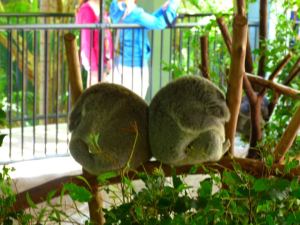Realism in Animated Cartoons
The Simpsons, created in 1989 by Matt Groening is the longest running American sitcom. The plot revolves around the family patriarch, Homer Simpson, and his wife and three kids, Bart, Lisa and Maggie. The Simpsons was the first animated cartoon dedicated to realism, combining aspects of the sitcom and animation, attracting a broader audience. “The commitment to realism changed viewers’ perceptions of television animation, which became very much the status quo,” (Crawford). Family Guy, created in 1999 by Seth MacFarlane is very similar to The Simpsons, however it is more ridiculous and less dedicated to realism. Like The Simpsons, the plot revolves around the family patriarch, Peter Griffin, and his wife Lois and three kids Meg, Brian and Stewie. Family Guy represents the idea of magical realism, the juxtaposition between reality and the fantastic, (Crawford). One of the elements of magical realism is the representation of the phenomenal world.
This essay explores the idea that the animated cartoon shows such as The Simpsons and Family Guy, include culturally relevant situations and a sense of realism in their content. They are in a realistic setting and the characters portray human qualities. They depict problems in society in every day life using satire and exaggeration to create funny situations. The many different locations and characters add depth and richness to the plot.
Realistic Setting
Family Guy and The Simpsons have a more realistic setting than typical Saturday morning cartoons and sitcoms with real people. Their goal was to make the viewer forget they were watching a cartoon. Even the slightest differences make the show seem more realistic. For example, “unlike the glossy, featureless backgrounds traditionally associated with animation. The trash and cracks are subtle signs of the imperfection of reality,” (Crawford). The Flintstones is often credited as the first show to combine animation and sitcom, however Groening was more committed to realism. The Flintstones share their world with dinosaurs and some of them are even characters in the show that can talk. The Simpsons, unlike The Flintstones and other cartoons display a sense of spatial reality. Groening mentions in an interview with Erik H. Berman that while “Fred Flintstone might run past 35 windows in his living room. If The Simpsons ran 20 feet, they would run into a wall,” (Crawford). Family Guy also respects spatial reality and the characters often run into walls.
The Simpsons live in the fictional town of Springfield, one of the most common town names in the US. Some argue that Family Guy is more realistic in this sense. Although they live in a fictional town, Quahog, it displays the real setting of Providence County in Rhode Island showing the skyline of Providence in the background. The characters have New England accents and there are many references to clams, the state fish in Rhode Island. According to Seth MacFarlane “rather than being a limitation this specific setting adds richness of the show, which gains considerable texture from its overt immersion in Rhode Island culture,” (Crawford).
Human Qualities of the Characters
The characters in The Simpsons and Family Guy display human qualities making them more realistic and believable. In order for to overcome the stereotype that cartoons are only for children and attract a broader audience, The Simpsons “had to behave-think, laugh, cry-like you and me” (Crawford). Groening abandoned typical attributes of Saturday morning cartoons to help distinguish The Simpsons from other animated shows. He insisted the Simpsons obey the law of physics, (Crawford). Other cartoons often “plunge thousands of feet off cliffs or get blown up by mountains of dynamite and appear in subsequent frames with no damage,” (Batchelor, 238). The Simpsons are not as resilient; when they are injured they would actually get bruised. The characters in Family Guy obey the law of physics as well, and when they are injured it shows. The characters are not invincible like in other cartoons, portraying more human qualities. These characters are more believable and adult viewers are more likely to identify with characters that have these more realistic physical attributes. The physical attributes are not the only aspect of the characters that represent human characteristics.
The audience can relate to the realistic personalities of the Griffin family and the Simpson family. The different charisma of each family member, and their less than perfect qualities make the family dynamic more realistic. The Simpsons is marked as one of the most accurate depiction of an American suburban family. The family patriarch in The Simpsons, Homer, is large and dimwitted “more devoted to drinking beer and eating doughnuts than taking care of his family,” (Booker, 49). Despite causing a lot of trouble, the audience regards Homer as a fool rather than a villain. They are sympathetic and forgive his stupidity because of his many redeeming qualities, “Homer is at heart a good soul, oddly lovable, and given to doing the right thing in the final analysis,”(Booker, 49). The family patriarch in Family Guy, Peter resembles Homer, however his behavior is even more outrageous and he gets into more trouble. Homer likes to drink beer, whereas Peter drank 37 beers at a bachelor party and passed out on the kitchen table in the first episode. Even though Peter’s antics are more ridiculous the audience sympathizes and identifies with him, “Peter, despite being a buffoon, also has a realistic side and an odd charm sometimes becoming a genuine object of sympathy as he attempts to cope with the failures of his life,” (Booker, 86). Although Homer and Peter are less intelligent than the average viewer, the audience can sympathize with these two characters.
Marge, the mother and wife in The Simpsons, is dedicated to her family but she gets frustrated with them from time to time, (Booker, 49). Lois, the mother and wife in Family Guy, is a stay-at-home mom as well, however she is not as conventional or conservative as Marge, (Booker, 84). Bart, 10, is the troublemaker in the Simpson family and resembles his father in many ways. He is a typical 10-year-old boy that would rather play than do his homework. Some argue that he is not a good role model for television, however he represents many students who do not try in school. According to Elizabeth Thoman, executive director of the Center for Media and Values, “’the fact that Bart is an underachiever and proud of it – well, I’m afraid there are a lot of these children,’” (Shales). One fan even admitted to calling his son Bart sometimes when he does something foolish, (Shales). Lisa, 8, is the brain of the family and always does well in school. Meg, 16, like Lisa, is intelligent but she must cope with issues such as being chubby and unpopular. Chris, 13, like Bart, resembles his father but rather than just being an underachiever he is described as “stupid and obese” (Booker, 83). Each member of the family in both of these shows have completely different personalities, creating a more honest reflection of the American family. Most agree they are more realistic than the ‘model family’ in other TV shows “’the slightly skewed perspective of The Simpsons makes them a far more human and believable family than such carefully conceived, endlessly responsible TV fascimiles as the Huxtables, the Keatons” (Mittell). The Simpsons and the Griffins are flawed and are far from perfect, but that is why the viewers can relate to them.
Family Guy takes one step further than The Simpsons, and two characters Brian, the dog, and Stewie, the baby, do not follow the social norms of a baby or a dog. They are both more mature and can speak at an adult level, which is an example of magical realism in Family Guy. However, they both demonstrate some typical attributes. For example, Stewie has a stuffed teddy bear and still relies on his mother for feeding and diaper changes, (Crawford). Brian sniffs other dog’s butts and occasionally pees on the floor, “thus, Brian is in many ways a normal dog and Stewie a normal infant, which combines their otherwise over-the-top portrayals to create a tremendous space for irony and incongruity,” (Booker 84).
Problems and situations in the society and everyday life
The Simpsons and Family Guy depict problems and situations in everyday life, in which the viewer can relate. These shows “tell stories that people can connect to, that are funny and actually have some sort of emotional resonance you don’t expect in a cartoon” (Crawford). The Simpsons appeal to a broader audience, attracting both younger and older viewers. Bart and Lisa are younger and some of the situations in their lives are less serious, however the younger viewers relate to them. They
“manage to tap genuine emotions and experiences, from violent video games to the euphoria of learning that school’s been cancelled by the season’s first heavy snow,” (Mittell). Meg and Chris are older than Bart and Lisa, which allows Meg, 16, and Chris, 13, “a number of new plot opportunities as the two teenage Griffins struggle to deal with puberty and the pressures of adolescence,” (Booker, 83). Meg must deal with the difficulties and strains of being a teenage girl, and the pressure to fit in.
Many episodes depict the family relationships of the characters in the Griffin family and the Simpsons family. Homer often feels the need to compare his family to another, often feeling like they are not as competent. In the episode “There’s No Disgrace Like Home” the Simpsons attend a picnic where Homer compares his unruly family to a more ideal family with well-behaved children, (Booker, 51). Although the Simpsons might misbehave “The Simpsons often veers into sentimentality in its depiction of the family as ultimately close-knit, despite the fact that they all seem to drive each other nuts” (Booker, 52). These shows also depict marital problems, and the struggles of remaining faithful and sexual.
The Simpsons and Family Guy portray the financial struggles of the working class, which is very rare in most shows with real humans. Most other shows such as, The Cosby Show, the main rival of The Simpsons in the early 90s, provides unrealistic expectations of the standards of living, “it provides a sanctuary from the real world, shielding the characters from the stress of social and financial hardship and thus keeping the ideal of the happy American family intact,” (Crawford). Most people living in the United States need to deal with issues like how they are going to pay the bills or send their child to college. The Simpson family and the Griffin family are the “backlash against the vision of the successful and happy American family” (Mittell). For example, in the first episode of The Simpsons, Homer doesn’t get a Christmas bonus, and Marge spends all their savings removing a tattoo from Bart’s arm. They struggle to get Christmas presents, and end up buying them at the convenience store. Homer is embarrassed of these Christmas presents compared to his neighbor’s lavish gifts, (Crawford). In the DVD commentary David Silverman said that it was James Brook’s idea to “’anchor the Simpsons economically and keep them mired in their money problems to make it real, because in most sitcoms people have no money problems whatsoever, or the money problems aren’t real,” (Crawford). In the first episode of Family Guy “Death Has a Shadow” Peter loses his job at the toy production company. In order to keep Lois from finding out he applies for welfare support, and buys extravagant items with this money. Many critics commend these shows for their realism in these financial struggles. There were t-shirts that said, “Cosby is the way it is supposed to be. The Simpsons is the way it really is – that’s life”
Many Characters and Locations Add Depth
Animated cartoons such as Family Guy and The Simpsons have more flexibility and freedom in creating environments and developing situations. They depict happenings in a whole town, rather than just the occurrences of the domestic setting. Other shows, like The Office only deals with issues at work while Family Guy and The Simpsons deal with issues at work, home, society, and much more. There are many more characters that add richness to the show. Other main characters in Family Guy such as Glenn Quagmire, Cleveland Brown, and Joe Swanson add diversity and versatility. Joe is a paraplegic, who was injured in the line of duty as a police officer. However, he has overcome his disability and is very strong and capable, (Booker 85). Other characters in The Simpsons play an important role such as C. Montgomery Burns, Homer’s boss at the nuclear power plant, satirizes the greed of the rich (Booker, 53). “A broad range of characters and settings allows for greater depth and complexity than had been seen in television animation before, making the animated world a more familiar place for the viewer,” (Crawford).
Conclusion
Family Guy and The Simpsons both have many of the same qualities. However, Family Guy is not as dedicated to realism, portraying aspects of magical realism, and often not following a plot. Family Guy disrupts the plot using non-sequiturs, pop-culture references, and cutaways to different scenes. Some argue that Family Guy is a blank parody, and is “meaningless, plagiarism, banality, laziness, and being formulaic” (Crawford). However, Crawford argues this is not the case and the plot disruptions represent how a majority of people receives information in the technological world in the form of either “channel surfing” or browsing the internet. The Simpsons and Family Guy both display many aspects of realism. The realistic settings, human qualities of the characters as well as the every day situations they deal with, and the broad range of characters and locations help achieve realism in these two TV shows.




